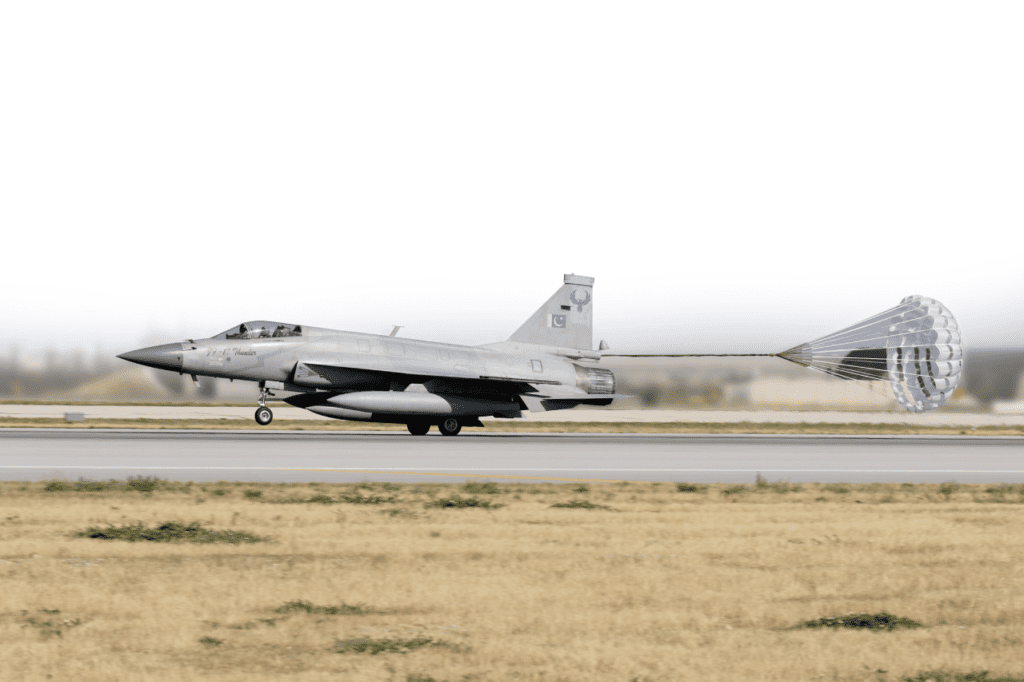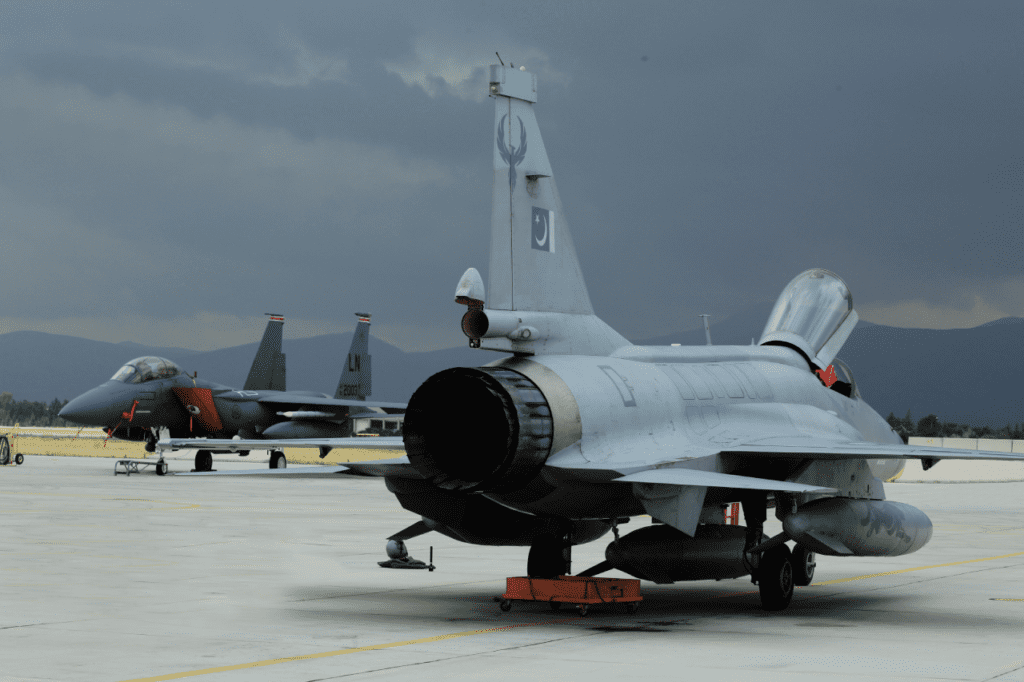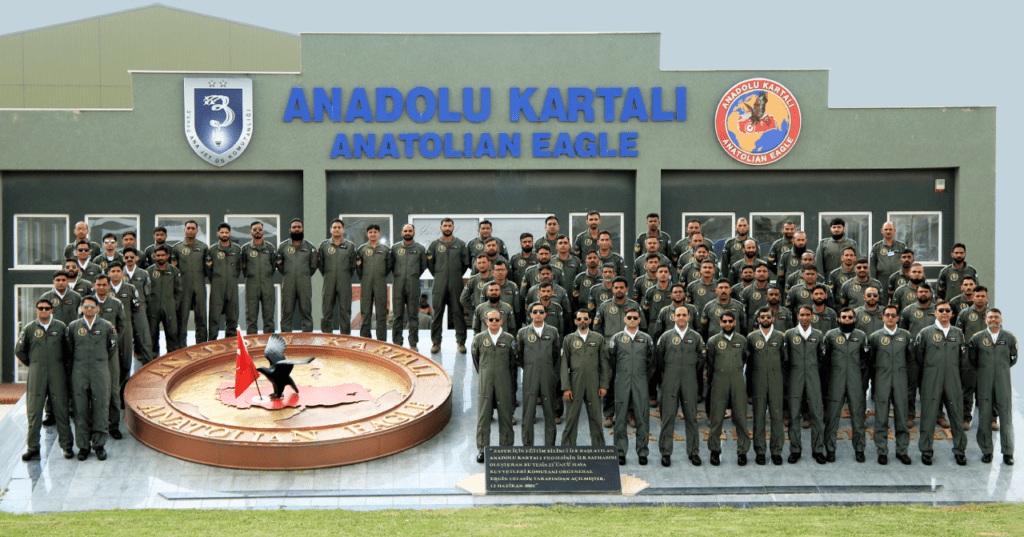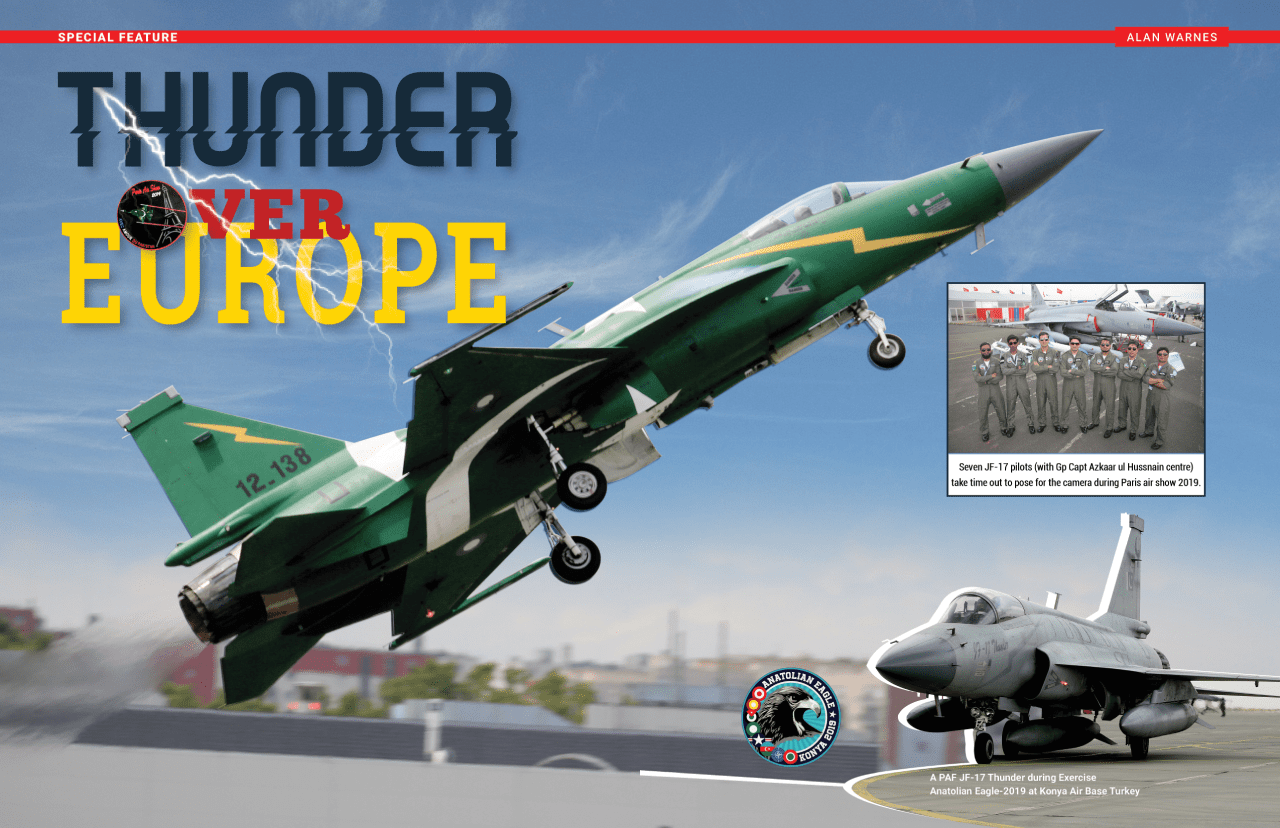Pakistan Air Force Thunders are no strangers to Europe. Having made their debut at Farnborough Air show in July 2010, they had subsequently visited Paris Air show (2015), Izmir Air show in Turkey (2011) and Radom Air show in Poland (2018).
The visits to Farnborough and Paris were purely commercial, driven in a bid to market the jet to the many military personnel who frequently visit these events. Those to Izmir and Radom were connected to the 100th anniversaries of both air forces in the countries with which the Pakistan Air Force has close relations. Why Poland, you may ask? History has it that several ex-Polish military personnel, including Air Cdre Wladyslaw Turowicz, helped build the Pakistan Air Force after independence and the end of World War II; the PAF never forgets.
Sending the aircraft so far is testimony to the reliability and the spirit of the PAF personnel who take the aircraft to these events, which can often mean nearly two weeks away from the home base.

Ferrying the aircraft for an air show involves several stops en-route and at least two night-stops, before arriving at the destination. Then, there is the set-up and practice for the flying displays, which the JF-17s usually get involved in. The PAF seems to get into the groove quickly and the personnel make it look easy because deployments are a regular occurrence for them, both inside and outside of Pakistan.
However, this year it was a little different for the Thunder force. Two squadrons were sent on two separate deployments for different reasons, simultaneously. After a gap of four years, the PAF opted to send three JF-17s from No 26 Squadron ‘Black Spiders’ to the Paris Air Show. Along with China National Aero-Technology Import and Export Corporation (CATIC), the PAF was keen to market the JF-17 and its capabilities to the West, and in particular, to the several African and Asian nations that frequent the exhibition. At the same time, five jets were deployed to Konya Air Base in Turkey where the Thunder made its first appearance in a European exercise. It must have put tremendous pressure on PAF’s logistical support which needed at least two C-130E Hercules for each deployment but the personnel are well-trained to handle it.
In 2015, similar commitments saw six F-16s deploy to Konya and three JF-17s head to Paris.
Now with 12 years of service that has seen the JF-17 amass over 40,000 flying hours, the aircraft is much more mature. With over 100 operational jets encompassing a variety of roles: air defense, air-to-ground and maritime strike, the PAF has substantial confidence not just in the aircraft but its people, as well. On 27th February 2019, during the strikes on India, the Thunder proved its worth and played a key role in the success of PAF’s ‘Operation Swift Retort’.
Paris
This year’s detachment to Paris Air Show, which took place from 17th to 23rd June was headed by Gp Capt Nauman Ali, a veteran JF-17 pilot and former OC of No 16 Sqn. He was supported by another JF-17 stalwart Gp Capt Azkaar ul Hussnain who flew the aircraft at Zhuhai Airshow in 2010. Both are veteran pilots, unsurprisingly, there is little these two pilots don’t know about the jet. The author was fortunate enough to fly in an air-to-air sortie with them, when they were Squadron Leaders serving No 16 Squadron, during Exercise High Mark 2010.
The whole detachment, comprising PAF air and ground crew left Pakistan on 9th June, then headed over to the Arabian Gulf, for a night-stop at Dhahran (Saudi Arabia), before leaving for Tabuk (Saudi Arabia) and a night-stop at Izmir-Cigli (Turkey). Pratica di Mare (Italy) was the next fuel stop before landing at Paris on the 11th. The unit tasked to take the Thunder to Paris, No 2 (Multirole) Squadron stood up just over three years ago, in April 2016. Leading the unit to arguably the world’s biggest aerospace show was the responsibility of Wg Cdr Jawad Gilani, the current OC.

Along with Wg Cdr Zeeshan Baryar and Sqn Ldr Bilal Raza, he led the three JF-17s from Karachi to Paris. The OC told the author, “It all went according to plan with plenty of time to prepare for the air show itself.”
In Paris, the two display pilots were the experienced Wg Cdr Zeeshan Baryar and Sqn Ldr Syed Sibtain. They carried out their practice demonstrations on June 13th and 14th and took turns to fly in the air show. Because of safety regulations, the aircraft were not allowed to manoeuvre at less than 1,500ft during the display. While the impressive JF-17 take-off we usually see at the shows was watered-down, Wg Cdr Baryar confided to the author that he reached 8G in the jet during the six-minute display. Baryar and Sibtain have joined an elite group of nine JF-17 pilots that have displayed the aircraft overseas, but Paris marks Baryar’s last show, having launched his career at Zhuhai Air Show 2016.
One JF-17 was displayed in the static show surrounded by a plethora of missiles and weapons that have been integrated on the jet. Two JF-17s were used for the flying display (one in Pakistan’s national colours and other in standard grey scheme). The green jet had a UAV kill marking on the left side of the cockpit. The drone was detected by radar flying over Panjgur Province on the night of 18th June, 2017 and was subsequently shot down with a PL-5EII, fired by Sqn Ldr Zeeshan Khan. Several such UAVs have suffered a similar fate in the past, after being tracked by the PAF but this was the first time the author had seen such markings on the side of a JF-17.
Konya
After three years of absence, Exercise Anatolian Eagle took place at Konya Air Base from 17th to 28th June and saw the JF-17 making its first appearance at a NATO exercise. Under the command of Gp Capt Ghazi Salahuddin, five JF-17 Thunder aircraft along with combat air and ground crew, technicians and maintenance crew participated in the exercise. No 28 Multirole Sqn ‘Phoenix’ was tasked with this huge responsibility, coming 14 months after standing up as a fighter squadron on 28th February, 2018. Other than PAF, this year’s international Anatolian Eagle 2019 Training Exercise included various air forces from around the world. Azerbaijan Air Force participated with 3 observers, U.S. Air Force with 6 x F-15Es, Italian Air Force with 3 x AMX A-11s, Qatar Air Force with 1 x C-17 and 1 x C-130J, NATO with 1 x E-3A, Royal Jordanian Air Force with 3 x F-16AM/BMs, Turkish Naval Force with 2 x Frigates and 1 Torpedo Boat. Turkish Air Force attended the event with 6 x F4E-2020s of the 111st Squadron, F-16C/D of the 113rd, 132nd, 152nd and 161st Squadrons, with KC-135R of the 101st Squadron, with E-7T of the 131st Squadron, with CN-235M and AS-532UL of the 135th Squadron and with C-160D “MİLKAR-2U” aircraft of the 221st Squadron.

All five Block-1 jets, which have served with a mix of other units, were fitted with three large fuel tanks as they would not be involved in any air combat. But due to the length of the missions and with no air-to-air refuelling system, the extra fuel was a necessity. Working with the Blue Force, they were probably being used as an escort to protect high value assets such as the Turkish Air Force E-7T AEW&C. The exercise was conducted with an aim to share experiences and tactics between all the participating assets. It strengthened military relationships and developed inter-operability with the participants to increase training level and combat readiness.
The Anatolian Eagle exercise dates back to the late 90s, when it was established as a national air warfare exercise. Following the participation of the Turkish Air Force in Red Flag in 1997, ambitions to enhance inter-operability of the exercise grew. Subsequently, the exercise commenced in June, 2001 at Konya Air Base with participation from the Turkish Air Force, United States Air Force and Israeli Air Force.








